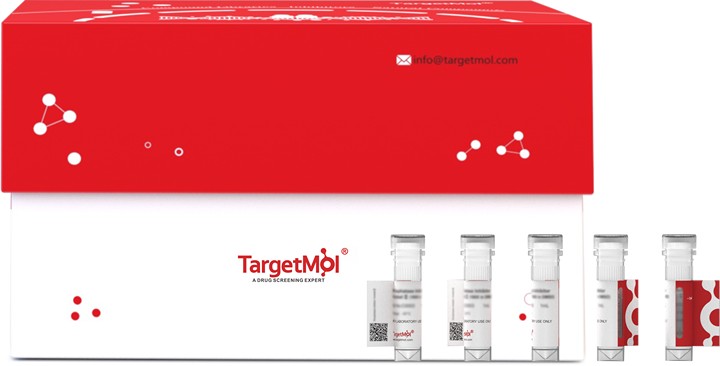 Your shopping cart is currently empty
Your shopping cart is currently empty
EXTL2 Protein, Mouse, Recombinant (His)
Exostosin-like 2 (EXTL2) is a member of the exostosin (EXT)-related family which contains five members: EXT1, EXT2, EXTL1, EXTL2, and EXTL3. Studies have shown that EXT gene family members have the activities of heparan sulfate-synthesizing glycosyltransferases. EXT1 and EXT2, which have been identified as causal genes for hereditary multiple exostoses, have HS-GlcAT-II and GlcNAcT-II activities. EXTL1 has GlcNAcT-II activity and EXTL3 has GlcNAcT-I and -II activities. EXTL2 has GlcNAcT-I and N-acetylgalactosaminyltransferase activities, and transfers a GlcNAc residue to the tetrasaccharide linkage region when this region is phosphorylated by a xylose kinase 1 (FAM20B) and thereby terminate chain elongation. In mice, lack of EXTL2 causes glycosaminoglycan (GAG) overproduction and structural changes of GAGs associated with pathological processes.

EXTL2 Protein, Mouse, Recombinant (His)
| Pack Size | Price | USA Warehouse | Global Warehouse | Quantity |
|---|---|---|---|---|
| 5 μg | $80 | 7-10 days | 7-10 days | |
| 10 μg | $129 | 7-10 days | 7-10 days | |
| 20 μg | $198 | 7-10 days | 7-10 days | |
| 50 μg | $390 | 7-10 days | 7-10 days | |
| 100 μg | $626 | 7-10 days | 7-10 days | |
| 200 μg | $987 | 7-10 days | 7-10 days | |
| 500 μg | $1,900 | 7-10 days | 7-10 days | |
| 1 mg | $2,730 | 7-10 days | 7-10 days |
Product Information
| Biological Activity | Activity has not been tested. It is theoretically active, but we cannot guarantee it. If you require protein activity, we recommend choosing the eukaryotic expression version first. |
| Description | Exostosin-like 2 (EXTL2) is a member of the exostosin (EXT)-related family which contains five members: EXT1, EXT2, EXTL1, EXTL2, and EXTL3. Studies have shown that EXT gene family members have the activities of heparan sulfate-synthesizing glycosyltransferases. EXT1 and EXT2, which have been identified as causal genes for hereditary multiple exostoses, have HS-GlcAT-II and GlcNAcT-II activities. EXTL1 has GlcNAcT-II activity and EXTL3 has GlcNAcT-I and -II activities. EXTL2 has GlcNAcT-I and N-acetylgalactosaminyltransferase activities, and transfers a GlcNAc residue to the tetrasaccharide linkage region when this region is phosphorylated by a xylose kinase 1 (FAM20B) and thereby terminate chain elongation. In mice, lack of EXTL2 causes glycosaminoglycan (GAG) overproduction and structural changes of GAGs associated with pathological processes. |
| Species | Mouse |
| Expression System | HEK293 Cells |
| Tag | N-6xHis |
| Accession Number | Q9ES89 |
| Synonyms | α-GalNAcT EXTL2,α-1,Glucuronyl-galactosyl-proteoglycan 4-α-N-acetylglucosaminyltransferase,Glucuronyl-galactosyl-proteoglycan 4-alpha-N-acetylglucosaminyltransferase,EXT-related protein 2,Extl2,Exostosin-like 2,Alpha-GalNAcT EXTL2,Alpha-1,4-N-acetylhexosaminyltransferase EXTL2 |
| Amino Acid | Asn43-Met330 |
| Construction | Asn43-Met330 |
| Protein Purity | Greater than 95% as determined by reducing SDS-PAGE. (QC verified) |
| Molecular Weight | 35 KDa (reducing condition) |
| Endotoxin | < 0.1 ng/µg (1 EU/µg) as determined by LAL test. |
| Formulation | Lyophilized from a solution filtered through a 0.22 μm filter, containing 20 mM Tris-HCl, 150 mM NaCl, pH 8.0. |
| Reconstitution | Reconstitute the lyophilized protein in distilled water. The product concentration should not be less than 100 μg/ml. Before opening, centrifuge the tube to collect powder at the bottom. After adding the reconstitution buffer, avoid vortexing or pipetting for mixing. |
| Stability & Storage | Lyophilized powders can be stably stored for over 12 months, while liquid products can be stored for 6-12 months at -80°C. For reconstituted protein solutions, the solution can be stored at -20°C to -80°C for at least 3 months. Please avoid multiple freeze-thaw cycles and store products in aliquots. |
| Shipping | In general, Lyophilized powders are shipping with blue ice. Solutions are shipping with dry ice. |
| Research Background | Exostosin-like 2 (EXTL2) is a member of the exostosin (EXT)-related family which contains five members: EXT1, EXT2, EXTL1, EXTL2, and EXTL3. Studies have shown that EXT gene family members have the activities of heparan sulfate-synthesizing glycosyltransferases. EXT1 and EXT2, which have been identified as causal genes for hereditary multiple exostoses, have HS-GlcAT-II and GlcNAcT-II activities. EXTL1 has GlcNAcT-II activity and EXTL3 has GlcNAcT-I and -II activities. EXTL2 has GlcNAcT-I and N-acetylgalactosaminyltransferase activities, and transfers a GlcNAc residue to the tetrasaccharide linkage region when this region is phosphorylated by a xylose kinase 1 (FAM20B) and thereby terminate chain elongation. In mice, lack of EXTL2 causes glycosaminoglycan (GAG) overproduction and structural changes of GAGs associated with pathological processes. |
Dose Conversion
Calculator
Tech Support
Keywords
| Size | Quantity | Unit Price | Amount | Operation |
|---|

Copyright © 2015-2025 TargetMol Chemicals Inc. All Rights Reserved.



